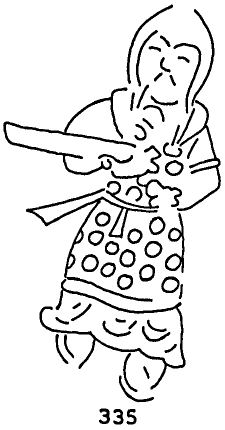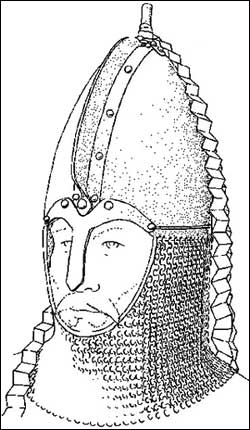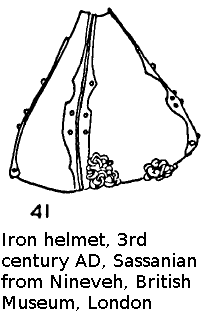
335. Glazed ewer from Hāmādan; late 7th century AD, Umayyad, ex-Demotte Coll., present location unknown

40. Iron helmet, late 3rd century AD, Sassanian, Dura-Europos, Yale University Art Gallery, New Haven.

Vol 1 pp. 218-220
The khūd
The khūd, khūdh or kūdhah was probably of Persian origin. Some authorities consider it to have been synonymous with the Arabic mighfar.41 and as such to have been a coif. Elsewhere it is made clear that these helmets were worn with coifs or aventails, sirash, chashmak or lithām, but were not synonymous with any of
41. Schwarzlose, op. cit., p. 350; Bivar, “Cavalry Equipment and Tactics on the Euphrates Frontier,” p. 291.
p.219
them.42 One such source states that a khūdhah islāmiyah had a solid ‘anf or nasal that could be bent but not broken by a javelin.43 This strongly suggests an iron helmet. Elsewhere, however, the khūdh is specifically described as being made of cuir-bouilli hardened leather.44 A third source could suggest that the helmet's construction included leather as it needed to be dried out rapidly if ever dropped in water.45
Al Tarṣūṣi's instructions for making a khūdh of cuir-bouilli show that its pieces were moulded, just as were the individual lamellae of a cuir-bouilli jawshan. He does not, unfortunately, indicate the precise shape and size of these pieces. Perhaps they were scales, for such helmets seem to have existed in medieval Islam,46 although some of the illustrated material could indicate mail (Figs. 65, 241, 420, 432, 447, 455, 578, 581, 629 and 651). On the other hand, segments of cuir-bouilli may have been riveted to an iron frame, thus forming a spangenhelm. Thirdly, a cuirbouilli khūdh may have been moulded almost in one piece with, perhaps, a separate neck-guard. Elsewhere the khūdh and presumed spangenheim tark are, however, clearly distinguished.47 Nevertheless, a Saracenic warrior in a khūdhah helmet could be mistaken for a Crusader,48
42. Ayyūqi, op. cit., verse 710; Mubārakshāh, op. cit., p. 252; Usamah ibn Munqidh, op. cit., pp. 46 and 124.
43. Usāmah Ibn Munqidh, op. cit., pp. 51-52.
44. Tarṣūṣi, op. cit., p. 116.
45. Firdawsī, op. cit., p. 344.
46. Mayer, Mamluk Costume, pp. 36-48; Robinson, Oriental Armour, p. 131.
47. Firdawsī, op. cit., pp. 369-370 and 431.
48. Usāmah ibn Munqidh, op. cit., p. 144.
p.220
among whose comrades spangenhelms were clearly popular.49
Taken altogether, this evidence need not contradict the suggestion that the khūd was essentially comparable to those generally low-domed, rounded or slightly pointed helmets with large neck-guards that appear in Persian and other pictorial sources. Their Sassanian origins are almost certain, and their gradual spread westwards corresponds quite closely to the spread of the khūd as indicated in the literary sources (Figs. 48, 50, 51, 53, 153, 175, 180, 196, 209, 210, 220A, 223, 224, 230, 241, 249, 256, 276, 292, 293, 294, 305, 306, 316, 335, 378, 392, 410, 416, 419, 421, 422, 447, 471, 474, 480, 484, 534, 571, 580, 597, 603, 606, 608, 609B, 634, 642C, 645A, 645B and 651).
Their shape could equally suggest, though by no means confirm, a cuir-bouilli construction. At this time inadequate metallurgical technology would surely have limited the large-scale production of helmets beaten from a single sheet of iron although, of course, such helmets were known to exist in various parts of the world. The fact that such presumed khūd helmets were often painted blue in various manuscript illuminations similarly need not prove that most were of iron. They also appear in a variety of colours and occasionally have fanciful shapes that make a metal construction most unlikely.
49. Ibn al Qalānisī, op. cit., p. 342.
-----------
Vol. 2 pp. 298-300
Iran
. . .
|
Helmets and other head protections in Sassanian Iran are well illustrated both in the art and by surviving specimens. Unfortunately, there is a lack of written material to help explain some of the more obscure pictorial sources. Coif and aventail are a case in point. Only in one source, and an immediately post-Sassanian one at that (Fig. 336), does the head-covering appear more likely to have been a coif under a helmet or cap, than an aventail attached to such a helmet. This crude piece of stucco-work was probably once painted. Although this may account for its apparent lack of surface detail, it does not help us to interpret the head-covering in question. Elsewhere an aventail of mail or scale is either strongly suggested in the art (Figs. 48, 50B, 51, 53A and 442), or is quite clearly shown as at Ṭāq-i-Bustān (Fig. 330). In no case does it join the hauberk; it invariably lies upon the shoulders of another garment, whether
p.299
of armour or not. Surviving helmets simply confirm this Iranian preference for aventails (Figs. 40 and 41).
As far as the helmets themselves are concerned, there is something of a clash between surviving specimens and most of the art. The former are generally tall, of the so-called Parthian Cap shape, whether of the early two-piece construction (Fig. 40) or of the later spangenhelm form (Figs. 55 and 56). All have straight lower edges and a symmetrically curved comb. Some of the art shows a similar outline (Figs. 51, 53A, 53B, 337 and 339), though in most cases an extra neck-guard is attached or some form of decorative covering, rim or plume, has been added. Only at Ṭāq-i-Bustān (Fig. 330) is a spangenhelm construction clearly shown, and here the helmet is of a low-domed outline in no way reminiscent of the Parthian Cap.
Elsewhere leather caps or hoods are suggested, though their outlines indicate a tall helmet, perhaps of the Parthian Cap shape, worn underneath (Figs. 48, 50B and 50C). In some such cases their lower outlines show the apparent flexibility of these helmet coverings, while in others the laces or headbands by which they are kept in place are equally apparent. In yet other sources a leather construction is argued by their smooth unriveted surface at a time when the large-scale production of helmets beaten from a single sheet of iron would probably have been beyond existing metallurgical capabilities. The probable survival of this style into early Islamic times is suggested by that admittedly far from clearly embossed ewer from Hamadān (Fig. 335).
The lacing or headband that held such leather or fabric helmet-coverings in position is seen on helmets alone, most obviously as Ṭāq-i-Bustān (Fig. 330), though also elsewhere (Figs. 331 and 337). Already it had acquired a decorative function over and above its
p.300
original purpose of tightening a helmet's lining around its wearer's head.
As such, the headband or enlarged lacing would subsequently become a very characteristic feature of Islamic arms and armour.